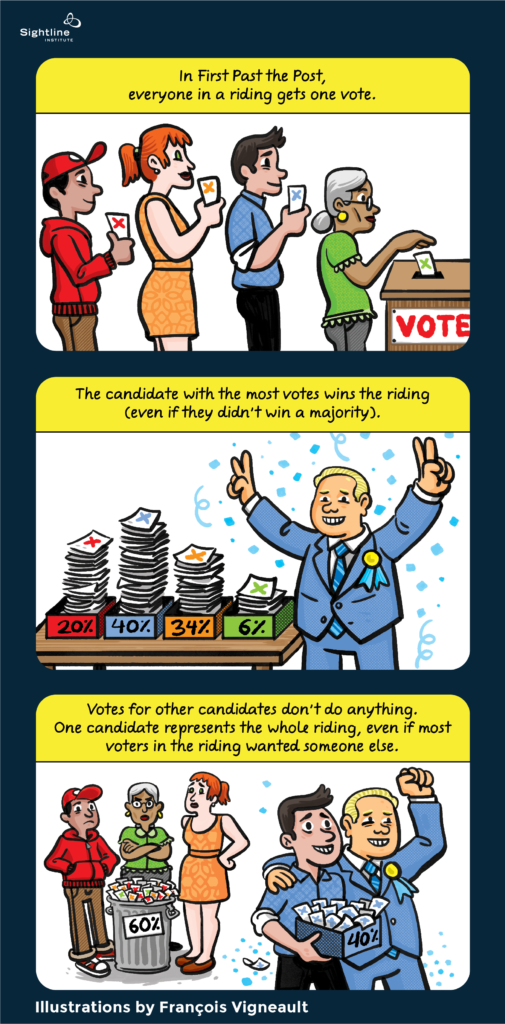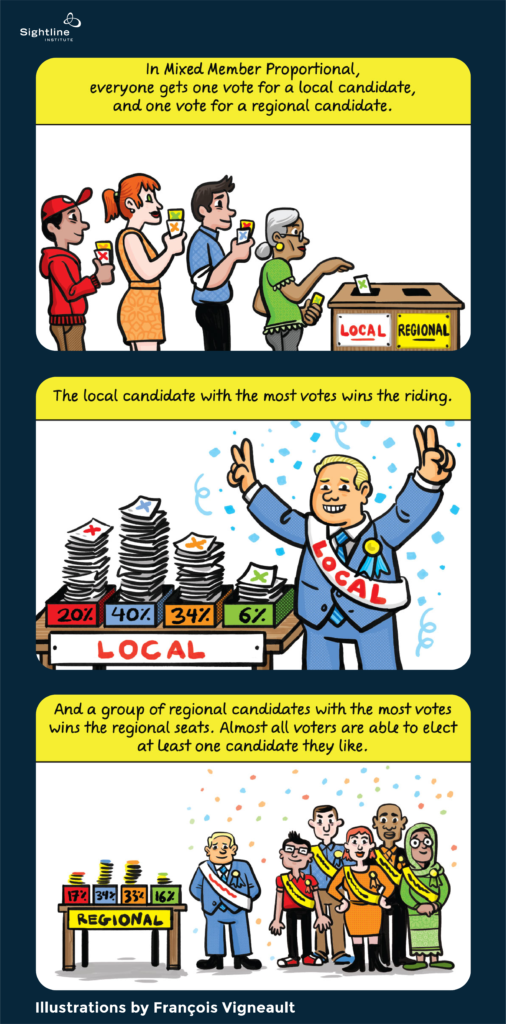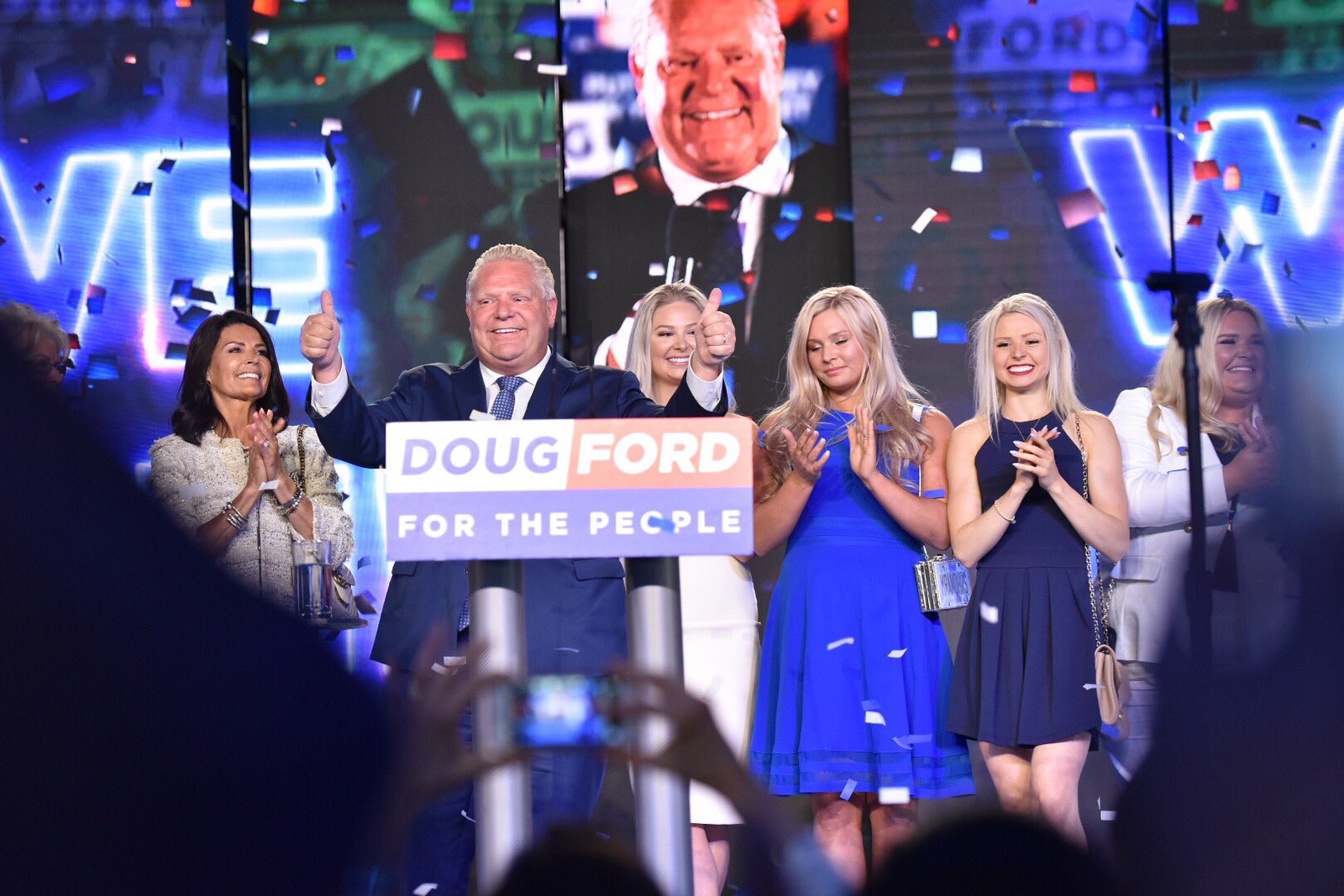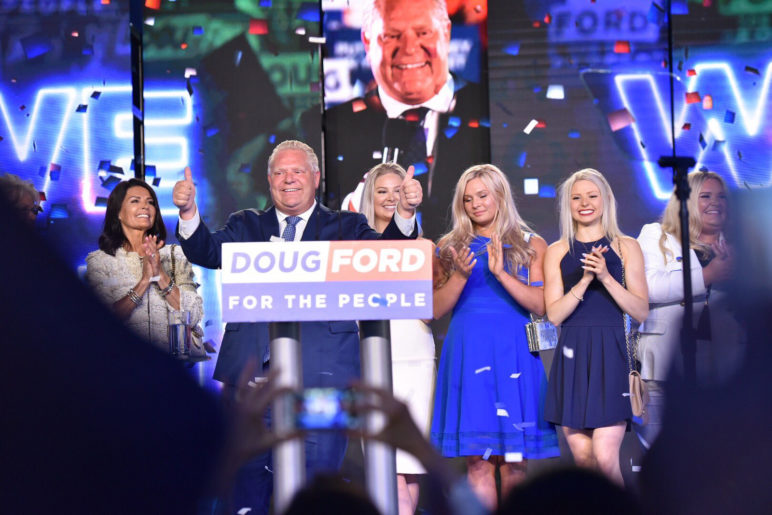This year, Doug Ford, whose brand of right-wing populism has drawn comparison to US president Donald Trump, took control of the Ontario government. Ford’s Progressive Conservative Party took majority control of the government with a minority of the votes because Ontario, like British Columbia and other places in Canada and the United States, uses a form of voting that distorts the will of the voters in elections.
British Columbia could elect an extremist like Ford, because it uses the same election method—the “First-Past-the-Post” (FPTP) system. In FPTP, the candidate with the most votes wins, even if he didn’t win a majority (as in American presidential elections). The Ontario Progressive Conservatives won only 40 percent of the votes but got a whopping 62 percent of the seats, and effectively 100 percent control of the legislative agenda. Unfortunately, this gap isn’t unusual under FPTP. In BC, ten of its past twelve elections under the FPTP system resulted in a party taking the lion’s share of power in the Legislative Assembly with less than a majority of votes. FPTP is vulnerable to extremist takeovers. Switching to MMP would protect the province against extremists taking charge.
FPTP is purported to be a direct line between elected officials and their constituents, but it is more like a funhouse mirror that distorts the shape of the parliament. Some voters, depending on where they live, have more power than others to elect their choice for a Member of Parliament (MP). In Ontario, for example, there is one Progressive Conservative MP for every thirty-one thousand Progressive Conservative voters. It took one-hundred-sixty thousand Liberal voters—five times as many—to elect a single Liberal MP. About 1.2 million people voted for a Liberal candidate, but the party holds just 7 of 123 seats.
Said another way, most voters got a local MP they did not want. Supporters of the FPTP system claim it offers two main benefits: 1) it gives voters a local representative who goes to the capitol on their behalf, and 2) it allows voters to hold representatives accountable to voters. But Ontario’s recent election shows how FPTP doesn’t deliver on those benefits.
To the first point, most Ontario voters didn’t send a local representative to Toronto on their behalf because the majority of voters didn’t want those representatives to begin with. Less than half of the Ontarians who voted chose the candidate who now represents them in Toronto. For example, in Ottawa West-Nepean, more than two-thirds of voters wanted someone other than Progressive Conservative candidate Jeremy Roberts, yet Mr. Roberts is their only representative in parliament. In most Ontario ridings (74 out of 123), most voters wanted someone other than the winner, so their representative likely isn’t vouching for their views and experiences.
For the second point, most voters in Ontario do not have an MP who answers to them so it’s difficult for voters to hold representatives accountable. If an MP doesn’t do a good job, he or she should theoretically get “fired” by getting voted out. For more than half the voters in Ontario, that argument is moot. In some places, the riding was so split between different candidates that it was hard to interpret the message voters were sending. In others, their riding was gerrymandered to be so safe for one party and protest votes don’t matter. In the Renfrew-Nipissing-Pembroke riding, Progressive Conservative incumbent John Yakabuski won with a landslide nearly 70 percent of the vote. With its agricultural and religious base, the riding is safe for conservative candidates. About ten thousand progressive NDP and Green voters registered their opposition to Yakabuski, but they can’t hold him accountable by voting against him because he is the only one representing the conservative riding.

Original Sightline Institute graphic, available under our free use policy.
Proportional Representation (ProRep) straightens out the mirror so the parliament accurately reflects the voters. If Ontario had used a form of ProRep, the Progressive Conservatives would have won about 40 percent of the seats, giving their voters a fair voice but forcing the party to make common cause with another party to gain control. Or, if the Liberals and NDPs were able to work together to get a combined 52 percent of voters, they could have joined together to form a government that actually represents the true majority of voters.
Aside from accurate overall representation in parliament, ProRep is better for individual voters. Where more than half of Ontario voters were left out in the cold after this year’s FPTP election if Ontario had used, for example, Mixed Member Proportional voting, most voters would have sent an MP of their choice to Toronto.

Original Sightline Institute graphic, available under our free use policy.
Doug Ford’s Progressive Conservative Party in Ontario gained in popularity this year, winning 40 percent of the vote fair and square. Those voters deserve 40 percent of the seats, but not complete control over parliament. The same thing could happen in BC as long as BC keeps using FPTP—an extremist party could rise far enough to take over in Victoria, even if it didn’t win majority support from BC voters. But if BC voters say yes to the fall referendum and switch to a form of ProRep, extremist parties will be limited by their popularity, and the will of the majority will ultimately prevail.











Richard Lung
“Switching to MMP would protect the province against extremists taking charge.”
Switching to MMP would protect the province against the voters taking charge. That is why the BC government took the opportunity to ram the BC Citizens Assembly recommendation (single transferable vote) off the road, with an injection of MMP, calling it RUP. This “new” voting system never was and most probably never will be used by anyone (certainly outside BC) and was never meant to do more than elbow out STV. The same goes for the novice DMP variant on MMP.
“…if Ontario had used, for example, Mixed Member Proportional voting, most voters would have sent an MP of their choice to Toronto.” MMP is a doubly safe seat system of dual candidates, it is impractical to reject. Because undemocratic, the Richard report and later the McAllister report recommended MMP be replaced by STV for the Welsh parliament.
(Editor:)
John Stuart Mill: Proportional Representation is Personal Representation.
The Angels Weep: H. G. Wells on Electoral Reform.
(Richard Lung:)
Peace-making Power-sharing;
Scientific Method of Elections.
Science is Ethics as Electics.
FAB STV: Four Averages Binomial Single Transferable Vote.
(in French) Modele Scientifique du Proces Electoral.
Jan Steinman
The problem with MMP is that it elects parties, not candidates.
Arguably a fairer method is ranked voting, in which you rank your selections, #1, #2, #3, etc. If no candidate gets a majority, the second-place votes are counted, then the third place, etc. until a candidate achieves a majority.
With ranked voting, a majority of the people always elect a candidate that they said they could tolerate, even if their absolute favourite wasn’t elected.
But ranked voting strengthens local representation at the expense of parties, so no one is really allowed to raise it as an alternative. In BC’s coming referendum on proportional representation, for example, voters get four choices, and none of them are ranked voting. We have the choice of FPTP, or three subtly different forms of mixed party proportional. This is like being given a choice of three different forms of fossil fuel, but no choice to use renewable energy.
Daryl Sturdy
@ Jan. Ranked voting is a poor replacement for PR. PT gives close to proportionality. Voters don’t have to hold their noses and vote for someone that they don’t like. Ranked voting is like being given a choice of 3 items on the menu one vegetarian, which you are, and the other 2 are meat.
Ian M MacKenzie
Don’t quibble the options, they’re all much more democratic and representative than is FPTP. If in doubt about the options, just vote for the first question and be done with it.